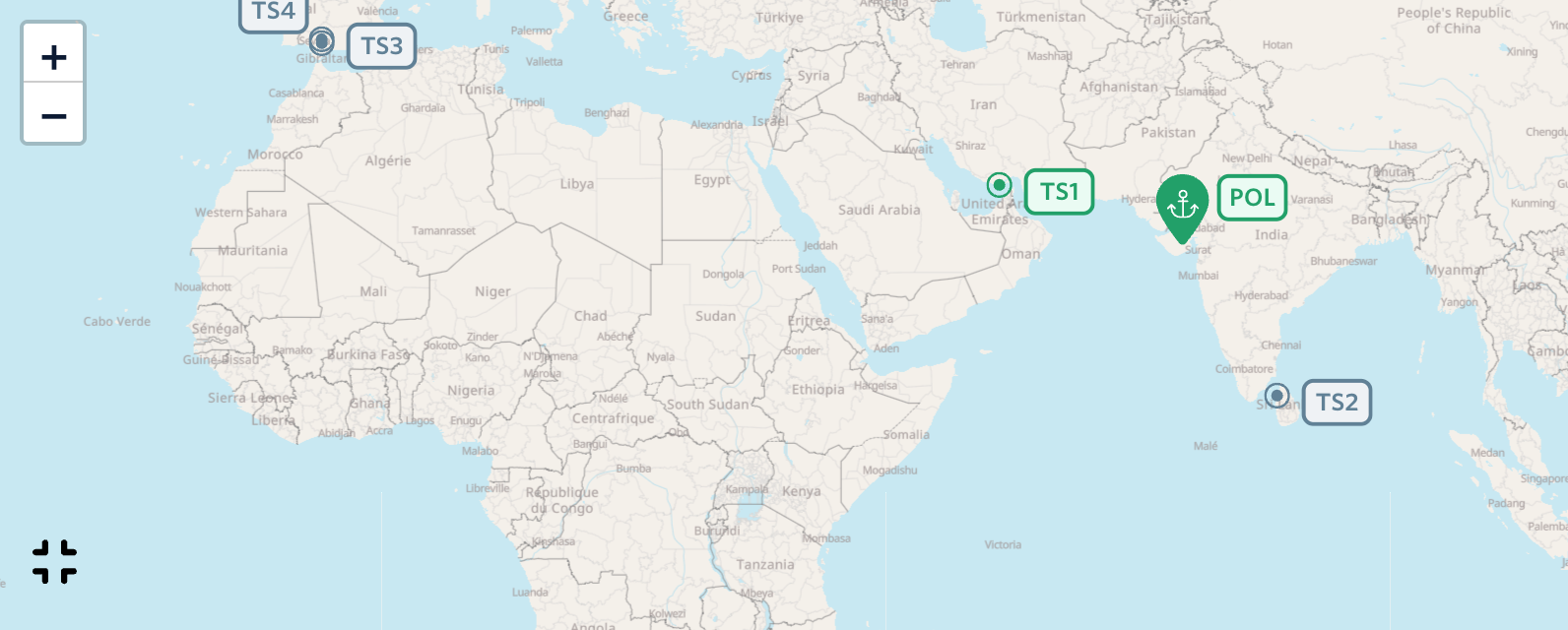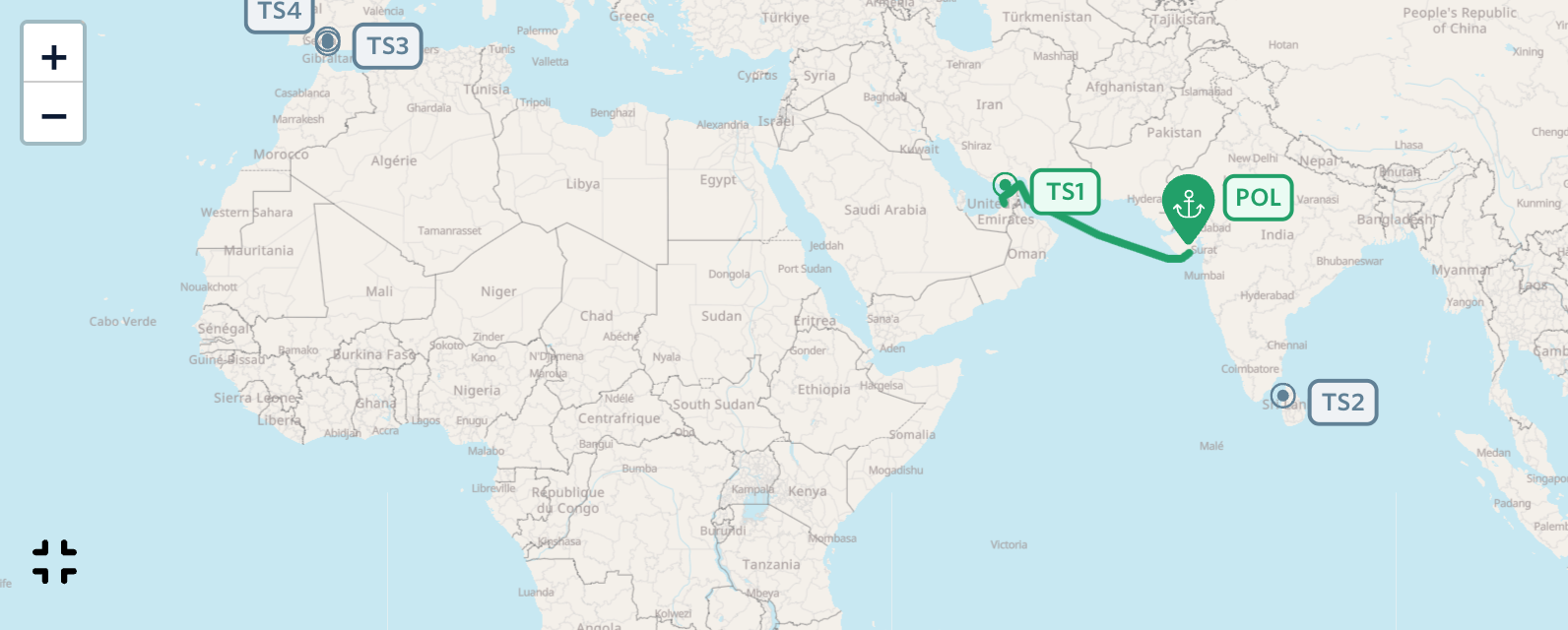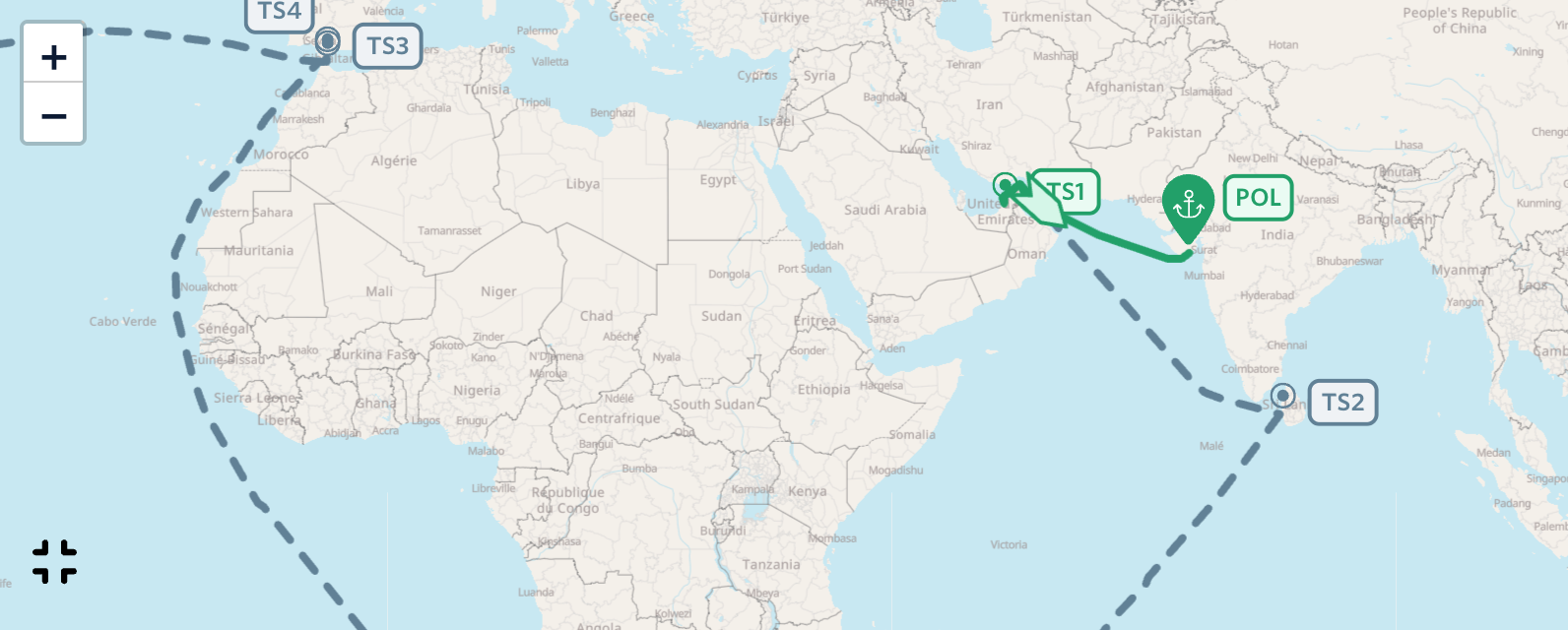In Depth Guides
Vessel and Container Route Data
This guide explains how to access detailed container routes and vessel positions data (historical and future positions) using Terminal49 APIs.
This is a technical article describing how to use our Routing Data feature, using the map as an example.

How to use:

How to use:
Using
This endpoint is used when the vessel is currently en route between two ports (e.g., has departed Port A but not yet arrived at Port B). It requires the vessel’s current coordinates as input, in addition to the port of departure and the port of arrival for the leg. The output is a predicted path from the vessel’s current location to the destination port.
(See: Get Vessel Future Positions with Coordinates API Reference)

Using
This endpoint is used when the vessel has not yet departed from the origin port of a specific leg. It takes the origin port (Port A) and destination port (Port B) of the upcoming leg as input and predicts a path between them.
(See: Get Vessel Future Positions API Reference)

Routing Data (Container Route and Vessel Positions APIs) is a paid feature. These APIs are subject to additional terms of usage and pricing. If you are interested in using these APIs, please contact sales@terminal49.com.
Table of Contents
- Overview of APIs for Mapping
- Visualizing Your Container’s Journey on a Map
- Use Cases
- Recommendations and Best Practices
- Frequently Asked Questions
Overview of APIs for Mapping
Terminal49 offers a suite of powerful APIs to provide granular details about your container shipments and vessel locations. Two key components are:- Container Route API: Offers detailed information about each part of your container’s journey, including port locations (latitude, longitude), vessels involved, and key timestamps. This is foundational for placing port markers on your map.
- Vessel Positions API: Provides access to historical and predicted future positions for the vessels.
Visualizing Your Container’s Journey on a Map
To create a map visualization of a container’s journey (similar to the embeddable map), you’ll typically combine data from several API endpoints. Here’s a step-by-step approach:Step 1: Plotting Port Locations
First, retrieve the overall route for the container. This will give you the sequence of ports the container will visit, along with their geographical coordinates. Use theGET /v2/containers/{id}/route endpoint. (See: Get Container Route API Reference)

API Request & Response Snippet for Port Locations
API Request & Response Snippet for Port Locations
Request
- Parse the
data.relationships.route_locations.dataarray to get the sequence of stops. - For each
route_locationobject (found inincludedusing its ID from the previous step), find its corresponding physicallocation(port) by looking up therelationships.location.data.idin theincludedarray (wheretypeisport). - Use the
latitudeandlongitudefrom the port attributes to plot markers on your map (e.g., POL, TS1, TS2 as shown in the image). - Each
route_locationinincludedalso contains valuable data likeoutbound_atd_at,inbound_ata_at,outbound_vessel.id,inbound_vessel.idetc., which you’ll need for the next steps.
Step 2: Drawing Historical Vessel Paths (Actual Route Taken)
For segments of the journey that have already been completed, you can draw the vessel’s actual path using its historical positions. Use theGET /v2/vessels/{id}?show_positions[from_timestamp]={departure_time}&show_positions[to_timestamp]={arrival_time} endpoint. (See: Get Vessel Positions API Reference

API Request & Response Snippet for Historical Paths
API Request & Response Snippet for Historical Paths
Request (Example for MAERSK BALTIMORE from Pipavav ATD to Jebel Ali ATA)
- From the
/containers/{id}/routeresponse, for each completed leg (i.e., both ATD from origin and ATA at destination are known):- Identify the
outbound_vessel.data.idfrom the departureroute_location. - Use the
outbound_atd_at(Actual Time of Departure) from the departureroute_locationas thefrom_timestamp. - Use the
inbound_ata_at(Actual Time of Arrival) from the arrivalroute_locationas theto_timestamp.
- Identify the
- Call the
/vessels/{vessel_id}?show_positions...endpoint with these details. - The
attributes.positionsarray will contain a series of latitude/longitude coordinates. Plot these coordinates as a connected solid line on your map to represent the vessel’s actual historical path for that leg (like the green line from POL to TS1 in the image).
Step 3: Drawing Predicted Future Vessel Paths
For segments that are currently underway or planned for the future, you can display predicted vessel paths. These are typically shown as dashed lines.Using GET /v2/vessels/{id}/future_positions_with_coordinates (For Vessels Currently En Route)
This endpoint is used when the vessel is currently en route between two ports (e.g., has departed Port A but not yet arrived at Port B). It requires the vessel’s current coordinates as input, in addition to the port of departure and the port of arrival for the leg. The output is a predicted path from the vessel’s current location to the destination port.
(See: Get Vessel Future Positions with Coordinates API Reference)

API Request & Response Snippet for Detailed Future Paths (Vessel En Route)
API Request & Response Snippet for Detailed Future Paths (Vessel En Route)
How to use:
- Determine if vessel is en route: From the
/containers/{id}/routeresponse, check if the leg has anoutbound_atd_atfrom the origin port but noinbound_ata_atat the destination port yet. - Get Current Vessel Coordinates:
- Identify the
outbound_vessel.data.idfrom the departureroute_location. - Fetch the vessel’s current details using
GET /v2/vessels/{vessel_id}. The response will contain its latestlatitude,longitude, andposition_timestampin theattributessection.Example: Fetch current vessel data
- Identify the
- Call
future_positions_with_coordinates:- Use the
location.data.idof the original departure port for this leg (asprevious_port_idor similar parameter, check API ref). - Use the
location.data.idof the final arrival port for this leg (asport_idor similar parameter). - Include the fetched current
latitudeandlongitudeof the vessel in the request.
- Use the
Hypothetical Request (e.g., TB QINGYUAN en route from Jebel Ali to Colombo)
- Plot the path: The
attributes.positionsarray will provide a sequence of estimated coordinates starting from (or near) the vessel’s current position. Plot these as a connected dashed line on your map (like the dashed line from the vessel’s current position between TS1 and TS2, heading towards TS2 in the image).
Using GET /v2/vessels/{id}/future_positions (For Legs Not Yet Started)
This endpoint is used when the vessel has not yet departed from the origin port of a specific leg. It takes the origin port (Port A) and destination port (Port B) of the upcoming leg as input and predicts a path between them.
(See: Get Vessel Future Positions API Reference)

API Request & Response Snippet for Future Paths Between Ports (Leg Not Started)
API Request & Response Snippet for Future Paths Between Ports (Leg Not Started)
How to use:
- Determine if leg has not started: From the
/containers/{id}/routeresponse, check if the leg has nooutbound_atd_atfrom the origin port (oroutbound_etd_atis in the future). - Identify vessel and ports:
- Get the
outbound_vessel.data.idthat will perform this leg. - Get the
location.data.idof the departure port for this leg (asprevious_port_id). - Get the
location.data.idof the arrival port for this leg (asport_id).
- Get the
- Call
future_positions:
Request (Example for CMA CGM COLUMBIA from Algeciras to Tanger Med - assuming not yet departed Algeciras)
- Plot the path: The
attributes.positionsarray will provide estimated coordinates for the full leg. Plot these as a connected dashed line on your map (like the dashed line from TS3 to TS4 in the image, assuming the vessel is still at TS3).
Combining Data for a Complete Map
By iterating through theroute_locations obtained from the initial /containers/{id}/route call:
- Plot all port markers (Step 1).
- For each leg of the journey:
- If the leg is completed (ATD and ATA are known), use the historical vessel positions API to draw a solid line (Step 2).
- If the leg is in progress or planned for the future (ATD known or ETD known, but ATA is not yet known or is in the future), use one of the future vessel positions APIs to draw a dashed line (Step 3).
Use Cases
Integrating Terminal49’s Vessel and Container Route APIs enables a variety of advanced capabilities:- Track Complete Shipment Journeys Visually: Monitor shipments across multiple legs on a map, from the port of lading to the port of discharge, including all transshipment points.
- Identify Transshipment Details Geographically: Clearly see where transshipments occur and the routes taken between them.
- Correlate Timestamps with Locations: Visually connect ETDs, ETAs, ATDs, and ATAs for every leg with their geographical points on the map for precise planning and exception management.
- Improve Internal Logistics Dashboards: Offer your operations team a clear visual overview of all ongoing shipments and their current locations.
Recommendations and Best Practices
- Polling Intervals: For routing data and vessel positions we recommend refreshing up to once per hour.
- Efficient Data Handling: Cache previous vessel positions when possible, as it doesn’t change. Focus polling on active vessel movements.
- Error Handling: Implement proper error handling for API requests, especially for future predictions which might not always be available for all routes or vessels.
- Data Layering: Consider layering information on your map. Start with basic port markers and paths, then add details like vessel names, ETAs, or status on hover or click.
- Map Library Integration: Use a robust mapping library (e.g., Leaflet, Mapbox GL) to handle the rendering of markers, lines, and map interactivity.
